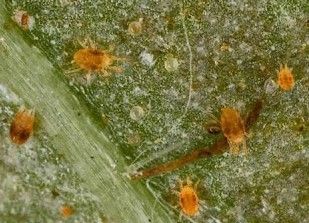By Bruce Potter and Bob Koch et.al
Two-spotted spider mites are taking advantage of the 2020 growing season’s hot weather. Mite infestations have been observed in soybean fields in Brown, Carver, Dakota, Le Sueur, McLeod, Lac Qui Parle, Redwood, Stearns and Yellow Medicine Counties. Several of these infestations have been economic.

Twospotted spider mites adults and eggs.
Spider mites are likely present in other areas as well, particularly where conditions have been dry. At this time, soybeans appear to have the heavier infestations although spider mites also attack corn and other crops.
Conditions that favor spider mites
In most years, two-spotted spider mite populations are kept in check by predators, fungal disease, and adequate moisture. Warm, dry weather and moisture stress of the crop favor mite reproduction. When conditions are favorable for the mites, their rapid life cycle and high reproductive rates can quickly result in large populations and crop damage. Other factors may accentuate mite populations, including some insecticides and fungicides. Once spider mite infestations are established and building, a single rainfall event or even short-term change in weather is not likely to stop an infestation.
Mites and their damage often show up on field edges first because the mites move into crops from adjacent perennial vegetation (pastures, roadside and drainage dishes, alfalfa fields, cover crops) where they overwinter. Populations on individual plants usually progress from lower leaves to the upper canopy. As infestations build and host quality deteriorates, mites readily disperse through the field by spinning a silk thread that’s caught by the wind. Dispersing mites colonize the remainder of the field with the infestation soon building throughout the field.
However this year, some fields are not following the typical patterns. Mites can be easily found in some fields that have not been dry or currently showing drought stress. Some of these infested fields have seen at least one heavy rainfall this season. In some cases, mites are present in the upper canopy and the infestations are not noticeably more severe near field borders.
Pesticide considerations
The presence of spider mites will affect pesticide decisions. Table 1 provides an overview of some important considerations for insecticides/miticides labeled for control of two-spotted spider mites in corn and soybean. In Minnesota, there is the potential for spider mites to be resistant to chlorpyrifos (e.g. Lorsban) and perhaps cross-resistant to dimethoate. Caution: Applications of many pyrethroid insecticides can flare spider mite populations and may not control soybean aphids. Additionally, there is evidence that, through several mechanisms, neonicotinoid insecticides may favor mite populations and fungicides may reduce the fungi that attack mites. Insecticides/miticides vary in which stages of mites they control. Surviving adults and immatures can continue to damage the crop and mite populations can rebound from uncontrolled eggs.
By the time infestations are detected on field edges, mites are likely well into the field. Because of this, border treatments are not advised. Before you spray, scout to make sure mites are still present. Because insecticide and fungicide applications can adversely affect biological control and otherwise impact spider mites, avoid unnecessary pesticide applications.
Table 1. Pesticides labeled for control of two-spotted spider mite (TSSM) on and corn and both TSSM and soybean aphid on soybean.
| Labeled for TSSM | | | Resistance concerns |
|---|
| Insecticide group | Common name | Trade name | Corn | Soybean | Labeled for SBA | TSSM stage controlled | TSSM | SBA |
|---|
| 1B - organophosphate | chlorpyrifos | Several*
(e.g. Chlorpyrifos 4E,
Govern 4E, Hatchet 4E,
Lorsban Advanced,
Lorsban 4E, NuFos 4E,
Warhawk 4E,
Whirlwind 4E,
Vulcan, Yuma 4E) | - | X | X | adults /immature | X | - |
| | dimethoate | Several*
(e.g. Dimethoate 4E, 4EC,
400, Dimate 4E, 4EC) | X | X | X | adults /immature | X | - |
| 3A - pyrethroid | bifenthrin | Several*
(e.g. Bifenture 2E,
Brigade 2E, Discipline 2E,
Fanfare 2E, Sniper 2E,
Tundra 2E) | X | X | X | adults /immature | - | X |
| 6 - chlorine channel activators | abamectin | Agri-Mek SC* | X | X | - | egg | - | - |
| 10A - hexythizox | hexythizox | Onanger | X | - | - | egg /immature | - | - |
| 10B -etoxazole | etoxazole | Zeal SC, Zeal, Zeal WDG (corn only) | X | X | - | egg /immature | - | - |
| 12C -propargite | propargite | Comite*, Comite II* | X | - | - | egg /immature | - | - |
| 23 -tetronic and tetramic acid derivatives | spiromesifen | Oberon 2 SC | X | - | - | egg /immature | - | - |
Mixtures
3A + 1A |
bifenthrin + chlorpyrifos |
Tundra Supreme* |
X |
X |
X |
adult /immature |
- |
- |
| 3A + 3A | zeta-cypermethrin + bifenthrin | Hero* | X | X | X | adult /immature | - | X |
| 1A + 3A | chlorpyrifos + gamma-cyhalothrin | Cobalt* | - | X | X | adult /immature | - | - |
| 1A + 4A | bifenthrin + imadacloprid | Swagger* | - | X | X | adult /immature | - | - |
| 3A + 44 (fungicide) | bifenthrin + Bacillus sp. | Ethos XB* | X | X | X | adult /immature | - | X |
*Restricted use pesticide
Always read and follow label directions
Products are mentioned for illustrative purposes only. Their inclusion does not mean endorsement and their absence does not imply disapproval.
Source : umn.edu